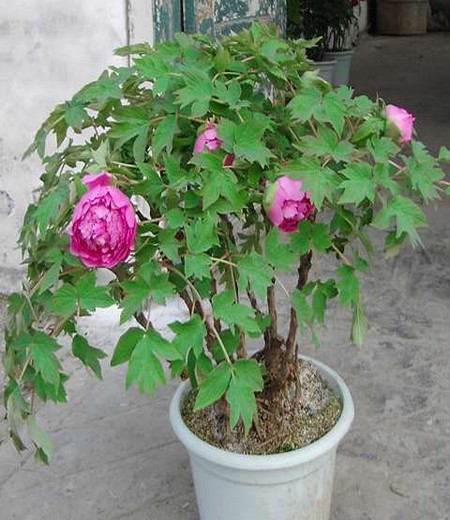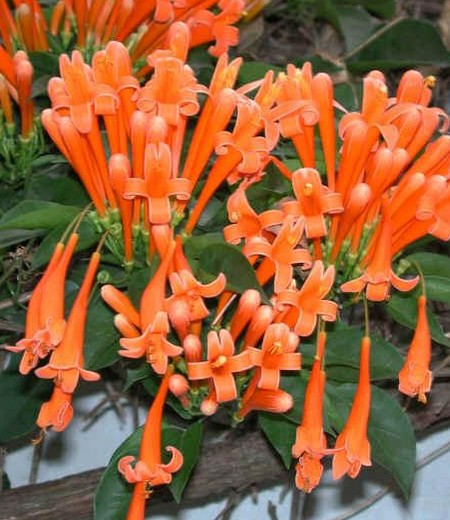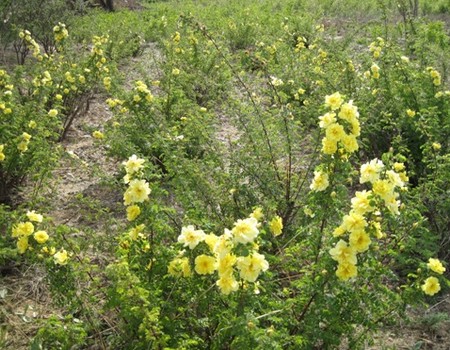Planting techniques and methods of Paeonia lactiflora
Peony is known as "flower immortal" and "flower phase", and is listed as one of the "six famous flowers", also known as "Mayflower God". Because it has been regarded as the flower of love since ancient times, it has been regarded as the representative flower of Qixi Festival. Paeonia lactiflora has high ornamental and medicinal value, remarkable planting benefit and great market potential, so it is a new industry.

Paeonia lactiflora, also known as Ligao, greedy spring, Yu Rong, ploughing, belongs to perennial root flowers, originated in northern China, at present, there are wild species in Qinling Mountains, Dabie Mountains and other places. Before planting peony flowers, it is necessary to select places with high dryness and good drainage, requiring deep, loose and fertile sandy urban soil. When planting in saline-alkali areas, it is necessary to change the soil; when planting in lower areas, to build a high platform, there should be sufficient clean water sources for irrigation. Next, let's take a look at the planting method of peony flowers.
[time]
No matter sowing seedlings or ramet seedlings were planted from late August (the End of Heat) to late September (the Autumn Equinox) in Heze and from late September (the Autumn Equinox) to early November (the Beginning of Winter) in Yangzhou. It is usually carried out in combination with ramet.
[specification]
The row spacing of ornamental cultivation plants in the garden can be 1 m × 1 m, and the planting points can be arranged in "product shape", so that the land can be used uniformly and reasonably, which is beneficial to the symmetrical growth of plants, but the field operation is sometimes inconvenient for field management and observation and recording. the horizontal and vertical "square" arrangement is often used. The specification of the planting hole, the depth is about 35cm, the diameter of the upper mouth is 18cm, the digging pit should be narrow at the top and wide at the bottom, the thick root should not be removed during ornamental cultivation and propagation, and the root-promoting seedling after rooting is used in medicinal cultivation (Zhejiang Dongyang method), the hole is naked about 25 cm. If you directly use the peony root after planting, the depth can also be shallow.
[land preparation]
Choose well drained and ventilated to the sun, deep soil layer, fertile loam or sandy loam is suitable, and wheat is the best in the previous crop. Cultivation requires intensive cultivation, deep ploughing 20-40cm, ploughing once or twice, combined with ploughing per hectare application of farm manure 2400-60000kg as base fertilizer, ploughing, making beds.
[soil]
Good drainage, peony like cool climate, China's temperate zone to subtropical areas are suitable for cultivation, with spring sprouting, autumn rooting characteristics, in summer. In the hot and hot season, the plant is semi-dormant, like sandy loam with loose fertility and good drainage, and avoid saline-alkali soil. Because peony is a fleshy root, it is resistant to drought but afraid of stagnant water, such as soil consolidation and stagnant water, it is easy to make peony fleshy root rot, so lowland and saline-alkali land are not suitable for cultivation.
Therefore, the ground planting should choose cool and sunny places, pot planting avoid watering too much. The whole dormant period from winter to early spring, the soil should be kept moist, not too dry, but the drainage should be smooth, avoid stagnant water, otherwise the underground root is easy to rot to death.
[reproduction]
Ramet propagation is often used, and the planting of Paeonia lactiflora must be carried out from August to September, because at this time, the wound which is conducive to root healing and the germination of new roots, the bud head of Paeonia lactiflora has produced new roots, which is easy to break when planting, affecting the growth of the coming year. Dig up the old plant, cut the head of paeony from the root, select the thick shape, disease-free bud plate, according to the size and the number of buds, let the natural growth shape cut into pieces, each piece of buds 2 Mel 4, leaving 2cm long head under the bud to facilitate growth. Generally, the bud head of Paeonia lactiflora can be planted with 3-4hm2 per hectare, and it is suitable to plant every 4 to 5 years. The bud head of peony had better be planted as soon as it is cut. If it can not be planted in time, it should be stored in time. You can choose a cool, ventilated and dry place indoors, spread wet fine sand on the ground, stack the bud head up, and then cover the wet sand.
[planting]
When planting, it is easy to manage by planting according to the size of the bud head of peony. The distance between rows and plants is 50cm × 30cm, and 6 × 10 ~ 4-68 × 10 ~ 4 plants are planted per hectare. Hole planting, each hole put a piece, buried in the ground 3cm is appropriate. When planting, the soil is not easy to get too wet, so as not to cause rotten roots to affect survival. Cover wheat straw, leaves, etc., before rotten to keep the soil warm. In the first ten days of March of the following year, Paeonia lactiflora was removed before germination.
[management]
After ploughing, weeding, weeding, soil moisture conservation and seedling emergence in early spring, the middle ploughing should be shallow for 4 times a year, so as not to hurt the roots and die the seedlings. In late October, before freezing, the branches and leaves were cut off from the ground 7-10cm, and the soil was cultivated in the rhizome for about 15cm, in order to survive the winter. Drainage and irrigation water peony medicine like drought and fear of waterlogging, generally do not need irrigation, serious drought, can be irrigated once in the evening. Clear the ditch and drain in time in the rainy season to reduce the incidence of the disease. Topdressing fertilizer three times a year from the second year, each time topdressing, it is better to dig holes on both sides of the plant, details are shown in Table 1.
Picking buds in order to concentrate nutrients for root growth, lateral buds should be removed in time when budding every spring, and residual flowers should be cut off if there are no seeds left after flowering.
[florescence]
Paeonia lactiflora can not be short of water during the plant growth period, especially in the bud stage and flowering stage. At the same time, the buds should be thinned in time, and the lateral buds should be removed after they appear, so as to concentrate nutrients and make the top buds bigger. After the flowers withered, the pedicels should be cut off in time so as not to seed and consume nutrients.
Half a month after the blooming of peony, that is, late June, fertilization should be carried out to supplement the nutrients consumed in the flowering period of peony in time, and lay a good foundation for peony to enter the second vigorous growth period.
[harvest]
When the plant was withered and yellow in the middle of October, the aboveground stems and leaves were first cut, then carefully dug out the fleshy roots to peel off the mud, sun-dried, sliced, and dried into Radix Paeoniae Rubra; select the sturdy roots, peel them, boil them thoroughly for 1-2 days, soak them, soften them, rub them into slices, and dry them into white peony.
Time: 2019-05-25 Click:
- Prev

Planting techniques of potted firecrackers
Firecracker flowers are usually cultivated in the open air in balconies, balconies and courtyards, which need to be set up with wooden and iron climbing flower racks, and smaller potted plants can also be displayed in the living room during the Spring Festival, which can bring good luck to the home for a good year. In addition, it is also a good New year gift for relatives and friends.
- Next

Planting method of Rosa przewalskii
How to grow yellow thorn rose? Is it easy to grow yellow thorn roses in pots? Yellow thorn rose can be divided into single petal and multi-petal, all of which have good ornamental value. many people pot yellow thorn rose at home. Yellow thorn rose has strong cold tolerance and is an important flowering tree species suitable for cultivation in northern China in late spring and early summer. It is suitable for flower hedge and flower border.
Related
- Fuxing push coffee new agricultural production and marketing class: lack of small-scale processing plants
- Jujube rice field leisure farm deep ploughing Yilan for five years to create a space for organic food and play
- Nongyu Farm-A trial of organic papaya for brave women with advanced technology
- Four points for attention in the prevention and control of diseases and insect pests of edible fungi
- How to add nutrient solution to Edible Fungi
- Is there any good way to control edible fungus mites?
- Open Inoculation Technology of Edible Fungi
- Is there any clever way to use fertilizer for edible fungus in winter?
- What agents are used to kill the pathogens of edible fungi in the mushroom shed?
- Rapid drying of Edible Fungi

